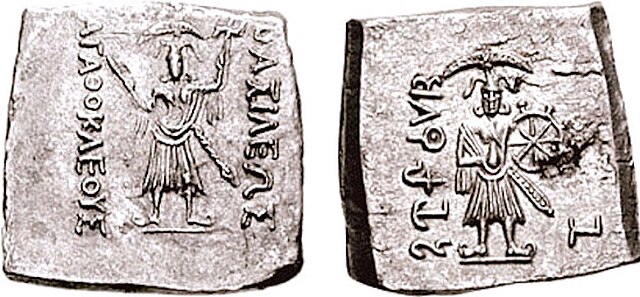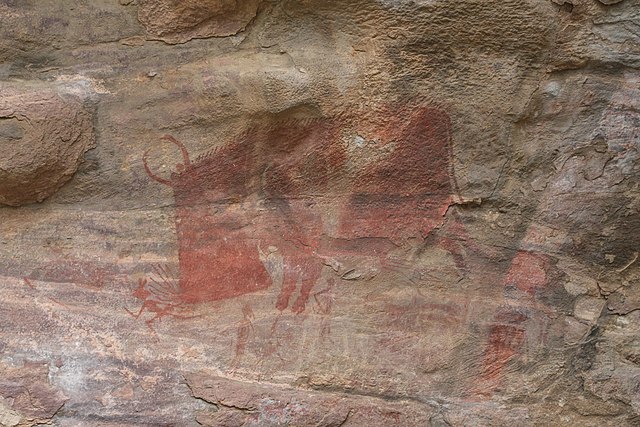Brahmi is a writing system of ancient India that appeared as a fully developed script in the 3rd century BCE. Its descendants, the Brahmic scripts, continue to be used today across Southern and Southeastern Asia.
Brahmi script on Ashoka Pillar in Sarnath (c. 250 BCE)
A northern example of Brahmi epigraphy: ancient terracotta sculpture from Sugh "Child learning Brahmi", showing the first letters of the Brahmi alphabet, 2nd century BCE.
A later (mistaken) theory of a pictographic-acrophonic origin of the Brahmi script, on the model of the Egyptian hieroglyphic script, by Alexander Cunningham in 1877.
Coin of Agathocles with Hindu deities, in Greek and Brahmi. Obverse: Balarama-Samkarshana with Greek legend: ΒΑΣΙΛΕΩΣ ΑΓΑΘΟΚΛΕΟΥΣ. Reverse: Vasudeva-Krishna with Brahmi legend:𑀭𑀸𑀚𑀦𑁂 𑀅𑀕𑀣𑀼𑀓𑁆𑀮𑀬𑁂𑀲 Rājane Agathukleyesa "King Agathocles". Circa 180 BCE.
Anatomically modern humans first arrived on the Indian subcontinent between 73,000 and 55,000 years ago. The earliest known human remains in South Asia date to 30,000 years ago. Sedentariness began in South Asia around 7000 BCE; by 4500 BCE, settled life had spread, and gradually evolved into the Indus Valley Civilisation, which flourished between 2500 BCE and 1900 BCE in present-day Pakistan and north-western India. Early in the second millennium BCE, persistent drought caused the population of the Indus Valley to scatter from large urban centres to villages. Indo-Aryan tribes moved into the Punjab from Central Asia in several waves of migration. The Vedic Period of the Vedic people in northern India was marked by the composition of their large collections of hymns (Vedas). The social structure was loosely stratified via the varna system, which has been incorporated into the highly evolved present-day Jāti-system. The pastoral and nomadic Indo-Aryans spread from the Punjab into the Gangetic plain. Around 600 BCE, a new, interregional culture arose; then, small chieftaincies (janapadas) were consolidated into larger states (mahajanapadas). A second urbanisation took place, which came with the rise of new ascetic movements and religious concepts, including the rise of Jainism and Buddhism. The latter was synthesised with the preexisting religious cultures of the subcontinent, giving rise to Hinduism.

Timeline of Indian history
Mesolithic rock art at the Bhimbetka rock shelters, Madhya Pradesh, showing a wild animal, perhaps a mythical one, attacking human hunters. Although the rock art has not been directly dated, it has been argued on circumstantial grounds that many paintings were completed by 8000 BCE, and some slightly earlier.
A dolmen erected by Neolithic people in Marayur, Kerala, India.
Stone Age (6,000 BCE) carvings of Edakkal Caves in Kerala, India.








